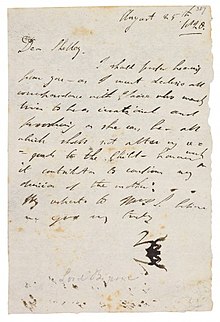
The letters of Lord Byron, of which about 3,000 are known, range in date from 1798, when Byron was 10 years old, to 9 April 1824, a few days before he died.[1][2] They have long received extraordinary critical praise for their wit, spontaneity and sincerity. Many rate Byron as the greatest letter-writer in English literature,[3][4][5] and consider his letters comparable or superior to his poems as literary achievements.[6][7][8] They have also been called "one of the three great informal autobiographies in English", alongside the diaries of Samuel Pepys and James Boswell.[9] Their literary value is reflected in the huge prices collectors will pay for them; in 2009 a sequence of 15 letters to his friend Francis Hodgson was sold at auction for almost £280,000.[10]
- ^ Marchand 1973, p. 39.
- ^ Marchand 1981, pp. 152–154.
- ^ Weeks, Edward (1949). "The Peripatetic Reviewer". Atlantic Monthly. 183: 76. Retrieved 26 December 2017.
- ^ Foot, Michael (1988). The Politics of Paradise: A Vindication of Byron. London: Collins. p. 100. ISBN 0002172550. Retrieved 26 December 2017.
- ^ Lansdown 2015, p. xxiii.
- ^ Donoghue, Denis (14 April 2016). "Review of Byron's Letters and Journals: A New Selection". The Irish Times. Dublin. Retrieved 26 December 2017.
- ^ Murray, John, ed. (2011) [1922]. Lord Byron's Correspondence. Volume 1. Cambridge: Cambridge University Press. p. x. ISBN 9781108033947. Retrieved 26 December 2017.
- ^ Marchand 1981, p. 1.
- ^ Lansdown 2015, p. xi.
- ^ "Byron's letters get nearly USD 460,000 at UK auction". The Hindu. Chennai. 30 October 2009. Retrieved 26 December 2017.
